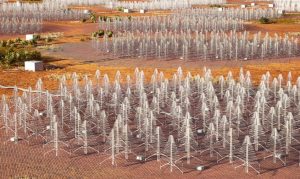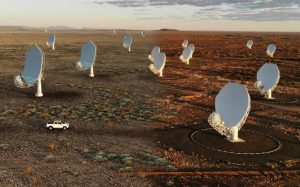“The SKA project has been many years in the making,” said Cesarsky. “Today, we gather here to mark another chapter in this 30-year journey that we’ve been on together. We are starting construction of the SKA telescopes.”
Over €300m worth of construction contracts were announced at the twined-ceremonies: €200 million for infrastructure in Australia and South Africa and €100 million to make antennas for both telescopes. This follows more than 40 contracts worth over €150m in the last 18 months. Allocated funds now total close to €500m, according to the SKA organisation.
 SKA-Low (left) in Australia will 50MHz to 350MHz with 131,072 christmas-tree-like stick antennas over 512 individual stations – the maximum baseline is around 65km.
SKA-Low (left) in Australia will 50MHz to 350MHz with 131,072 christmas-tree-like stick antennas over 512 individual stations – the maximum baseline is around 65km.
At 110MHz, its field of view is expected to be 327arcminutes and maximum resolution 11arcseconds. System timing is planed to be better than 10ns. ~7.2Tbit/s is the expected data flow
SKA-Mid in South Africa (top image) is the 350MHz to 15.4GHz dish array, with 197 antennas including 64 dishes from the existing MeerKAT array. At 1.4GHz it will have a view of 60arcmin and 0.3arcsec resolution, shifting to 12.5arcmin and 0.06arcsec respectively at 6.7GHz. Better than 5ns is the system target and 8.8Tbit/s is the expected flow.
The plan is for these data streams are to be combined and reduced to ~5Tbit/s by front-end processing, after which they will enter a ~250Pflop/s scientific computer whose annual output will be, it is currently estimated, around 710Pbyte/year.
Images:
SKA-Low – artists impression
SKA-Mid – artist impression on left side, blended with photo of MeerKat on right

